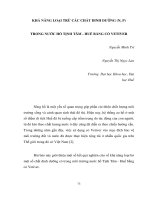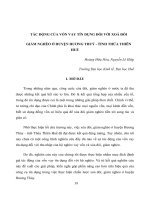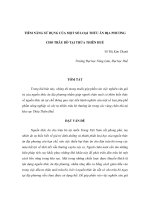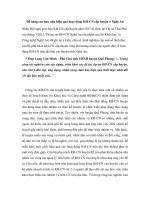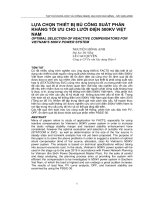Báo cáo nghiên cứu khoa học: "TÁC năng lực NHÂN LỰC VỀ THỰC HIỆN DỰ ÁN CÁC DỰ ÁN HẠ TẦNG VIỆT NAM" pps
Bạn đang xem bản rút gọn của tài liệu. Xem và tải ngay bản đầy đủ của tài liệu tại đây (317.86 KB, 10 trang )
TẠP CHÍ PHÁT TRIỂN KH&CN, TẬP 10, SỐ 08 - 2007
Trang 5
THE EFFECT OF HUMAN RESOURCE COMPETENCIES ON PROJECT
PERFORMANCE
IN VIETNAMESE INFRASTRUCTURE PROJECTS
Cao Hao Thi
(1)
, Fredric William Swierczek
(2)
(1) University of Technology, VNU-HCM
(2) Asian Institute of Technology, Thailand
ABSTRACT: This study develops a conceptual framework for determining the
components of human resource competencies and project performance. The effects of human
resource competencies on project performance are identified. The scope of the study is limited
to infrastructure projects in Vietnam. The sample consisted of 239 project members and
managers currently involved in infrastructure projects in Vietnam.
In the conceptual framework of this study, the indicators of project performance are
cost, time, technical performance and customer satisfaction as used in previous studies. The
key components of human resource competencies are mainly based on indicators developed by
Belassi and Tukel [1]. These components are project manager competencies and team member
competencies. The relationships in the conceptual framework were analyzed by Structural
Equation Modeling (SEM) techniques with the application of SPSS and AMOS software. The
results indicated that the human resource competencies demonstrate a significantly positive
influence on project performance.
Keywords: Human Resource Competencies, Project Performance, Vietnam.
1. INTRODUCTION
Since 1980, many academics and practitioners have agreed that human resource
management is one of the most crucial elements of an organization’s success. Project
management has become a key activity in most modern organizations [2]. The Project
Management Institute in its official definition of Project Management Body of Knowledge
(PMBOK) included human resource management as one of nine fundamental basic functions
of project management [3]. However, the results of the empirical studies conducted by Pinto
and Prescott [4], and by Belout and Gauvreau [2], contradict this emphasis. Pinto and Prescott
concluded that the ‘Personnel factor’ was not a dominant variable for project success at any of
the life cycle stages. Belout and Gauvreau indicated that the ‘Personnel factor’ did not have an
impact on dependent variable of project success.
This study attempts to respond to their controversial findings. This study will investigate
the effects of human resource competencies on project performance of infrastructure projects
in Vietnam, a developing country.
This study will consider key project factors of human resource competencies as they relate
to project performance criteria. It assesses infrastructure projects in Vietnam to examine the
relationship between these factors and the performance of projects.
2. LITERATURE REVIEW
2.1. Project Performance Criteria
One focus of project management research has been on establishing the attributes of
effective project performance and the factors that facilitate effective project performance.
Science & Technology Development, Vol 10, No.08 - 2007
Trang 6
Traditionally, project performance had been defined in term of meeting cost, time and quality
criteria [5].
Tukel and Rom reported an empirical study conducted in the USA to determine the
performance measures project managers commonly use to evaluate the success of their
projects [6]. Specifically, they identified the project manager’s orientation toward using
internal and/or customer driven measures of performance. In general, they found that the
project manager’s primary measure is quality and their most important objective is meeting
customer needs.
According to Kerzner [7], project performance was defined as the completion of an
activity within the constraints of cost, time, and performance. This definition of excellent
performance has been modified to include completion within budgeted cost, within the
allocated time period, at the proper specification level and the customer’s satisfaction.
2.2. Key Project Factors of Human resource competencies
The search for critical project factors has been continuing for more than three decades.
Most early studies in this area focused on the reasons for project failure rather than project
success. Rubin and Seeling [8] investigated the relationship of the project manager’s
experience on the project’s success or failure. The findings indicate that a project manager’s
previous experience had a minimal impact on the project’s performance [9]. The size of the
previously managed projects did not influence the manager’s performance. Avots identified
the reasons for project failure and concluded that the wrong choice of project manager, the
unplanned projects termination and unsupportive top management were the main reasons for
failure [10]. Hughes conducted a survey to identify the factors that affect project performance
[11]. He concluded that projects fail because of the improper focus of the management system,
by rewarding the wrong actions, and the limited communication of goals. However, to
understand failure does not guarantee success in the future. Replicating the critical success
factors in new projects has been suggested as the more effective approach to improve project
performance [12].
Belassi and Tukel [1] grouped critical success factors into four areas: external
environment, project manager and team members, organization, and the project. The
identification of critical factors would lead to the better evaluation of projects. Critical factors
are linked to their effects which lead to project success or failure. The identification of this
cause-effect relationship would improve project performance [13].
In summary, most previous studies consider that project performance criteria should
include cost, time, technical performance and customer satisfaction. This means the success of
a project was defined as the completion of an activity within budgeted cost, within the
allocated time period, at the proper technical performance and with acceptance of the customer
[7]. Many studies in project management have presented human resource competencies factors
including two main components of manager and team members of project. Key project factors
of human resource competencies need to be determined as successful based on the level of
performance accomplished. There is limited research on the strength of the relationship
between the human resource competencies and project performance. Some results of the
empirical studies concluded the ‘Personnel factor’ did not have an impact on project success.
This contradicts the trend in project management in which the human resource competencies
usually plays important role in the success of organizations or in the performance of projects.
TẠP CHÍ PHÁT TRIỂN KH&CN, TẬP 10, SỐ 08 - 2007
Trang 7
3. HYPOTHESIS
In the literature, many factors related to the competencies of project managers and team
members have been proposed for the successful completion of projects. These factors not only
affect project performance but they also have an impact on client satisfaction and project
acceptance [14]. Pinto and Slevin [15] demonstrated the importance of selecting project
managers who possess the necessary technical and administrative skills for successful project
completion. The project manager’s competence becomes most critical during the planning and
termination stages [16]. The competence of the team members is also found to be a critical
factor throughout the project cycle [17]. Similarly, well-established communication channels
between the project manager, the organization and the client are necessary for the acceptance
of the project outcome by the client. Thamhain [18] conducted a field study to examine the
influences of the project environment on team performance and resulting project performance.
He found a positive relationship between team involvement and performance especially in
complex project environments.
This discussion leads to specific hypothesis about the relationships between the human
resource competencies, including project manager and team members’ competencies, and
project performance.
Hypothesis: In a project, the higher the competencies of the project human resource the
better the project performance.
4. RESEARCH METHODOLOGY
4.1. Operationalization and measurement
This study will examine the effects of human resource competencies on the project
performance. The indicators of project performance and its antecedent factors of human
resource competencies will be measured by the perception of project managers of
infrastructure projects in Vietnam.
The indicators of project performance will be cost, time, technical performance and
customer satisfaction as used in previous studies. The measurement of these concepts focuses
on capturing the extent to which a project has been successful based on results. The indicators
of human resource competencies are mainly based on the two sets of factors that developed by
Belassi and Tukel [1]. These indicators are the project manager competencies and the project
team member competencies. In this conceptual framework, two factors of project manager
competencies and team member competencies are considered as first order constructs; and
human resource competencies are treated as higher order construct. The competencies of
project manager are measured in terms of: ability to delegate authority, to negotiate, to
coordinate, to make decisions, and to specify role and responsibility. The competencies of
project team members are measured specified as: technical background, communication skills,
trouble shooting, commitment, problem solving, and teamwork.
4.2. Research design
The research setting is infrastructure projects in Vietnam. The questionnaire was designed
to include a description of the project in terms of demographic characteristics, a perception of
project performance and a perception of project factors of human resource competencies
The questionnaire required respondents to think of a project in which they were currently
involved or had recently completed. This project was to be their frame of reference for
completing the questionnaire. The questionnaire includes 10 questions related to project
characteristics, 4 questions related to project performance, 11 questions related to project
Science & Technology Development, Vol 10, No.08 - 2007
Trang 8
factors of human resource competencies, and a few open ended questions. Each item about
project performance and project factors of human resource competencies were measured on
scale ranging from 1: strongly disagree to 7: strongly agree. Data were collected using a self-
administered survey. Questionnaires were mailed to 1000 potential respondents, who were
involved in infrastructure projects in Vietnam. 239 usable questionnaires were returned, a
response rate of approximately 24%. Finally, a focus group was also conducted with the
project professionals in infrastructure projects in HoChiMinh City to discuss about the counter
intuitive results identified in this research. There were 21 participants in the focus group.
4.3. Descriptive statistics
A frequency analysis is conducted for questions related to background of the project. This
information includes the position of respondents in the project, type of project, ownership,
number of activities, total budget, organizational structure, stages of project, and work
experience of members. 69% of the projects were state owned. Nearly half of the projects
averaged million to 5 million US dollars per project. 44% were in the implementation stage
and 22% were completed. Most of the projects were in industrial plants or infrastructure (road,
etc.) The majority of projects had a range from 50-150 specific activities. The dominant
project structure was functional. Most projects also tended to be longer term between 2-10
years in duration.
The findings from the descriptive statistics present some interesting patterns. The most
important Manager Competencies related to the role and responsibilities of a project manager.
Clearly, being in the position is not sufficient. The project manager through experience,
training and development or from appropriate delegation has to understand what is required in
their role and the expectations related to their performance. The ability to make decisions and
understand trade offs are related competencies which can affect the project manager’s
performance. Members of a project team primarily need to have an appropriate technical
background and communication skills, but also to apply this expertise flexibly through
problem solving and trouble shooting.
The results of correlation analysis show that these independent variables of human
resource competencies are all significantly correlated with the dependent variables of project
performance. These results are supportive of the findings developed from past research. They
suggest the key role of the project manager, the capability and flexibility of project members.
4.4. Factor analysis of Key Human resource competencies Factor
Factor analysis was used to reduce the 11 human resource competencies variables into
meaningful sub-sets of factors. Table 1 shows the results in which a two factor solution
emerged. The first factor, Member Competencies, includes the competencies of project team
members in problem solving, trouble shooting, commitment, team work, communication
skills, and technical background. The second factor, Manager Competencies, includes the
abilities of project manager to make decisions, to coordinate, to negotiate, to delegate
authority, and to exercise responsibility. The two factors are described Table 1. Overall, the
measures of the different constructs are clearly distinguishable from each other. This provides
evidence for satisfactory discriminant validity.
The second purpose of this factor analysis is to assess the multidimensional nature of
perceived project performance. The project performance criteria were operationalized as cost,
time, technical performance and customer satisfaction. A factor analysis determined that
project performance should be considered a unidimensional construct. This analysis shows that
TẠP CHÍ PHÁT TRIỂN KH&CN, TẬP 10, SỐ 08 - 2007
Trang 9
only one factor was extracted and specified as Project Performance. The results are presented
in Table 2.
The two key human resource competencies factors had eigenvalues greater than 1,
accounting 70.48% of the cumulative variance; and the project performance has an eigenvalue
greater than 1, and accounting 57.82% of the variance. These match the acceptable criteria for
factor analysis: an eigenvalue more than 1, at least 50% variance being explained, and
simplicity of factor structure. Cronbach’s alpha was used to assess the reliabilities for the three
groups of key human resource competencies project factors and the project performance. The
Member Competencies and Manager Competencies, had reliabilities of 0.90 and 0.91
respectively. The project performance reliability was 0.73.
Table 1. Results of Factor Analysis for the Member and Manager Competencies
Factor 1:
Member Competencies
Factor 2:
Manager Competencies
Problem solving .884
Trouble shooting .859
Commitment .737
Teamwork .687
Communication skills .673
Technical background .630
Ability to make decisions .895
Ability to coordinate .824
Ability to negotiate .782
Ability to delegate authority .757
Ability to perceive role and
responsibility
.691
Eigenvalues 6.579 1.174
Variance explained (%) 59.81 10.67
Cronbach alpha 0.9001 0.9128
Table 2. Results of Factor Analysis for Project Performance
Factor 1:
Project Performance
Technical performance .828
Customer satisfaction .712
Cost .599
Time .505
Eigenvalues 2.313
Variance explained (%) 57.817
Cronbach alpha 0.7283
Science & Technology Development, Vol 10, No.08 - 2007
Trang 10
4.5. Structural Equation Modeling Approach
In this study, a conceptual framework was developed to determine the important human
resource competencies factors in project performance. The framework considered the
relationships between the key factors of human resource competencies and project
performance. In this conceptual framework, two factors of project manager competencies and
team member competencies are considered as first order constructs; and human resource
competencies are treated as higher order construct. The variables of two first order constructs
and the relationships between the constructs and project performance were presented in more
detail in Figure 1. These relationships were analyzed by Structural Equation Modeling (SEM)
techniques with the application of the AMOS software.
The SEM results are shown in Figure 1. These results indicate that there are two factors
including Manager Competencies, and Member Competencies which had a significantly
positive relationship with Human Resource Competencies and finally affect to Project
Performance. The model achieved a convergence with 7 iterations. The SEM model
maintained GFI = 0.941, TLI = 0.971 and CFI = 0.977. All of these indices fall into the
acceptable range of overall fit (greater than .90). The model RMSEA was 0.053 and Chi
square was 86.13 with 52 degrees of freedom, which indicates a satisfactory fit of the model to
the data. This confirmed the validation and the generalizability of the proposed constructs as
well as the overall fit of the observed data.
The SEM model in Figure 1 shows that four items of performance criteria including cost,
time, technical performance and customer satisfaction are significantly related to project
performance at the .05 level. Technical performance (.81) has the strongest relationship to
Project Performance, followed by customer satisfaction (.74), cost (.58) and time (.52). The
model shows that four items consisting of the abilities of project manager to make decisions,
to coordinate, to negotiate, and to delegate authority were related significantly to Manager
Competencies.
Ability to coordinate (.85) has the strongest relationship, followed by the ability to make
decisions (.84), ability to negotiate (.82), and ability to delegate authority (.80). Member
Competencies includes problem solving, trouble shooting, commitment, and technical
background. Problem solving (.92) has the strongest relationship to Member Competencies,
followed by trouble shooting (.81), goal commitment (.80), and technical background (.66).
The Manager Competencies and Member Competencies demonstrate a significant relationship
with human resource competencies and finally affect to Project Performance.
The findings indicate that Manager Competencies exerts the highest impact on Human
resource competencies (.86), followed by Member Competencies (.84). The results also
indicate that a Human resource competency has high impact on Project Performance (.62). The
empirical results provide statistical evidence to support the hypothesis was developed to
examine the relationships in the conceptual framework.
TẠP CHÍ PHÁT TRIỂN KH&CN, TẬP 10, SỐ 08 - 2007
Trang 11
Figure 1. SEM Results of Conceptual Framework
Project
Performance
Human
Competencies
Manager
Competencies
Member
Competencies
Coordinate
Make
Decision
N
egotiate
Delegate
Authority
Problem
Solving
Trouble
Shooting
Goal
Commitment
Technical
Background
Cost
Custome
r
Satisfaction
Time
0.81
0.58
0.52
0.62
0.85
0.84
0.82
0.80
0.86
0.84
0.92
0.81
0.80
0.66
Technical
Performance
0.74
Science & Technology Development, Vol 10, No.08 - 2007
Trang 12
5. CONCLUSIONS
This study examined the relationships between the key Human Resource Competencies
factors and Project Performance that were developed into a conceptual framework. These
relationships were analyzed by Structural Equation Modeling (SEM) techniques using AMOS.
This is an application of a new statistical methodology in the field of project management. The
SEM results supported the hypothesis of the relationships in the conceptual framework. The
results confirmed that the factors of Manager Competencies and Member Competencies had a
positive and significant relationship with Human Resource Competencies and finally impact
on Project Performance. These also provide confirmatory support to the human resource
competencies variables developed by Belassi and Tukel [1]. This confirmed the important role
of human resource competencies in project performance that stated from management theory.
The SEM model also demonstrated that four items of performance criteria including cost,
time, technical performance and customer satisfaction are significantly related to Project
Performance. This finding also determined that Project Performance can be considered a
unidimensional construct. The results indicated that the criteria of technical background and
customer satisfaction are more important than cost and time in the evaluation of the project
success. Four competencies including the abilities of project manager to make decisions, to
coordinate, to negotiate, to delegate authority were significantly related to the Manager
Competencies. For Member Competencies, problem solving, trouble shooting, goal
commitment, and technical background were significantly related to the Member
Competencies.
5.1. Implications
In the focus group, 57.1% of 21 Vietnamese professionals in infrastructure projects agreed
the results of this study concerned human resource competencies will contribute to the
improvement of the project management approaches in Vietnam. No one disagreed and 42.9%
gave other comments. Almost participants agreed the research findings are appropriate to the
infrastructure projects in public sector with small and medium scale (due to sampling). The
findings contribute to improving and completing the management of project with government
budget. Lesson can be drawn for public project management. In future, infrastructure
investment in Vietnam will see more private participation. Research should pay additional
attention to this trend.
In summary, there are significant implications of the results for practice. First, this study
assessed the literature available on project management to identify human resource
competencies factors and project performance, and assess infrastructure projects in Vietnam.
The results of this study supported the human resource competencies factors and the project
performance criteria developed in the literature review. From the results, the Vietnamese
project professionals as well as their peers throughout developing countries can recognize and
insure the key human resource competencies needed for better project performance. Secondly,
this study demonstrated that factors related to Manager Competencies and Member
Competencies that improve Project Performance. It suggests that more emphasis on
developing these competencies through more appropriate training and education such as
executive-level project management courses or decision making techniques for managers, and
project management tools for professionals in skills and certification may be very important
for the future success of projects. Appropriate training has an important part to play in
enhancing individuals’ preparedness and abilities to change [19]. Also, Cheng et al. found that
one of barriers to implementing new performance solutions stemmed from an absence of
appropriate training interventions that enhances human resource competencies [20].
TẠP CHÍ PHÁT TRIỂN KH&CN, TẬP 10, SỐ 08 - 2007
Trang 13
5.2. Limitations
When interpreting the results of this study, two issues have to be considered. This study
was concentrated on identifying the critical project factors of human resource competencies
and examining the causal effects between these factors and project performance. The use of a
subjective measurement approach is problematic. The focus of this study emphasized how the
project professionals working in infrastructure projects in Vietnam perceived project success
and its antecedent factors. There is certainly the possibility of bias in their responses. It is very
difficult to obtain an objective data of project performance or key project factors. Attitudinal
measures are a better indicator of human resource competencies factors in project
management. Another limitation involves the generalizability of the results because the
findings of this study are based only on the sample of infrastructure projects in Vietnam.
ẢNH HƯỞNG CỦA TRÌNH ĐỘ NGUỒN NHÂN LỰC ĐỐI VỚI HIỆU QUẢ
CỦA CÁC DỰ ÁN CƠ SỞ HẠ TẦNG TẠI VIỆT NAM
Cao Hào Thi
(1)
, Fredric William Swierczek
(2)
(1) Trường Đại học Bách khoa, ĐHQG-HCM
(2) Viện Công Nghệ Châu Á, Thái Lan
TÓM TẮT: Nghiên cứu này nhằm xác định các thành phần của năng lực nguồn nhân
lực và của thành quả dự án, đồng thời xác định mức độ ảnh hưởng của năng lực nguồn nhân
lực lên thành quả dự án. Nghiên cứu được giới hạn trong phạm vi các dự án cơ sở hạ tầng ở
Việt Nam. Mẫu dữ li
ệu được thu thập từ 239 nhà quản lý và nhân viên dự án có liên quan đến
các dự án cơ sở hạ tầng ở Việt Nam.
Trong mô hình nghiên cứu, các chỉ báo của thành quả dự án bao gồm chi phí, thời gian,
thành quả kỹ thuật và sự thỏa mãn của khách hàng đã được sử dụng ở các nghiên cứu trước
đây. Các thành phần chính của năng lực nguồn nhân lực chủ yếu được dựa trên các chỉ báo
đã được xây dựng b
ởi Belassi and Tukel [1]. Các thành phần này là năng lực của nhà quản lý
và của nhân viên dự án. Các mối quan hệ trong mô hình nghiên cứu đã được phân tích bằng
kỹ thuật Mô Hình Phương Trình Cấu Trúc kết hợp cùng phần mềm SPSS và AMOS. Kết quả
nghiên cứu đã khẳng định năng lực nguồn nhân lực có ảnh hưởng tích cực lên thành quả dự
án.
REFERENCES
[1]. Belassi, W. and Tukel, O.I., A New Framework for Determining Critical
Success/Failure Factors in Projects, International Journal of Project Management,
Vol. 14, No. 3, pp. 141-151, (1996).
[2]. Belout, A. and Gauvreau, C., Factors Influencing Project Success: The Impact of
Human Resource Management, International Journal of Project Management, Vol.
22, pp. 1-11, (2004).
[3]. Project Management Institute, A Guide to the Project Management Body of
Knowledge (PMBOK), (2004).
Science & Technology Development, Vol 10, No.08 - 2007
Trang 14
[4]. Pinto, J. K. and Prescott, J. E., Variations in Critical Success Factors over the Stages
in the Project Life Cycle, Journal of Management, Vol. 14, No. 1, pp. 5-18, (1988).
[5]. Bryde, D.J., Robinson, L., The Relationship between Total Quality Management and
the Focus of Project Management Practices, The TQM Magazine, Vol. 19, No. 1,
pp. 50-61, (2007).
[6]. Tukel, O.I. and Rom, W.O., An Empirical Investigation of Project Evaluation
Criteria, International Journal of Operation and Production Management, Vol. 21,
No. 3, pp. 400-416, (2001).
[7]. Kerzner, H., Project Management - A Systems Approach to Planning, Scheduling,
and Controlling, 7th ed. New York: John Wiley and Sons, (2001).
[8]. Rubin, I.M. and Seeling, W., Experience as a Factor in the Selection and
Performance of Project Managers, IEEE Transactions of Engineering Management,
Vol. 14, No. 3, pp. 131–134, (1967).
[9]. Abdul-Rahman, H. et al, Delay Mitigation in the Malaysian Construction Industry,
Journal of Construction Engineering and Management, 132:2, pp. 125-133, (2006).
[10]. Avots, I., Why Does Project Management Fail?, California Management Review, pp.
77-82, (1969).
[11]. Hughes, M.W., Why Projects Fail: The Effects of Ignoring the Obvious, Industrial
Engineering, Vol. 18, pp. 14-18, (1986).
[12]. Hawk, D., Conditions of Success: A Platform for International Construction
Development, Construction Management and Economies, 24:7, pp. 735-742, (2006).
[13]. Karlsen, J. et al, An Empirical Study of critical Success Factors in IT Projects,
International Journal of Management and Enterprise Development, 3:4, pp. 292-311,
(2006).
[14]. Procaccino, J. & J. Verner, Software Project Managers and Project Success: An
Exploratory Study, Journal of Systems and Software, 79, 1541-1551, (2006).
[15]. Pinto, J.K. and Slevin, D.P., Critical Success Factors in R&D Projects, Research
Technology Management, Vol. 32, No. 1, pp. 31-33, (1989).
[16]. Zwikael, O. & S. Globerson, Benchmarking of Project Planning and Success in
Selected Industries, Benchmarking: An International Journal, 13:6, 688-702, (2006).
[17]. Puthamont, S. & C. Chareonngam, Strategic Project Selection in the Public Sector,
International Journal of Project Management, 25, 177-188, (2007).
[18]. Thamhain, H., Linkages of Project Environment to Performance: Lessons for Team
Leadership, International of Project Management, Vol. 22, pp. 533-544, (2004).
[19]. Hansson, J., Backlund, F. and Lycke, L., Managing commitment: Increasing the
Odds for Successful Implementation of TQM, TPM or RCM, International of Quality
and Reliability Management, Vol. 20, No. 9, pp. 993-1008, (2003).
[20]. Cheng, M.I., Dainty, A. and Moore, D., Implementing a New Performance
Management System within a Project-Based Organization, International Journal of
Productivity and Performance Management, Vol. 56, No. 1, pp. 60–75, (2007).


